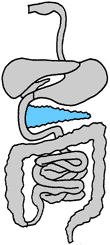 pancreas
pancreas
 H m m . . . l e t ' s t a l k
H m m . . . l e t ' s t a l k
a b o u t t h e p a n c r e a s !
p a n c r e a s
![]() The pancreas is located behind your stomach. It weighs at around half a pound
and it is a long, slender organ. Within the pancreas, concentrated in its
"tail", are very small groups of cells called the islets of
Langerhans. Paul Langerhans, after whom they were named, first discovered
the islets in 1869.
The pancreas is located behind your stomach. It weighs at around half a pound
and it is a long, slender organ. Within the pancreas, concentrated in its
"tail", are very small groups of cells called the islets of
Langerhans. Paul Langerhans, after whom they were named, first discovered
the islets in 1869.

![]() The pancreas has two main functions: 1.) exocrine: Your exocrine
part of the gland produces
enzymes
and other materials that are secreted
directly into your intestines to aid digestion; and 2.) endocrine:
Your endocrine pancreas monitors minute-to-minute changes in
glucose,
amino acids,
ketone bodies, and
fatty acids.
The endocrine pancreas responds
to those stimuli by secreting hormones from
alpha,
beta,
and
delta,
cells directly into the bloodstream.
The pancreas has two main functions: 1.) exocrine: Your exocrine
part of the gland produces
enzymes
and other materials that are secreted
directly into your intestines to aid digestion; and 2.) endocrine:
Your endocrine pancreas monitors minute-to-minute changes in
glucose,
amino acids,
ketone bodies, and
fatty acids.
The endocrine pancreas responds
to those stimuli by secreting hormones from
alpha,
beta,
and
delta,
cells directly into the bloodstream.
![]() Your pancreas secretes digestive juices which break down fats, carbohydrates,
proteins and acids. It also secretes bicarbonate, which neutralizes stomach
acid as it enters the duodenum. Some cells in the pancreas secrete hormones
that regulate the level of glucose in the blood.
Your pancreas secretes digestive juices which break down fats, carbohydrates,
proteins and acids. It also secretes bicarbonate, which neutralizes stomach
acid as it enters the duodenum. Some cells in the pancreas secrete hormones
that regulate the level of glucose in the blood.
p a n c r e a s q u i z
![]() Test your knowledge on the pancreas. Click on next to start the quiz, or move
on to the next section to skip the quiz.
Test your knowledge on the pancreas. Click on next to start the quiz, or move
on to the next section to skip the quiz.
back to top